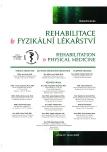Using the Czech Version of the Neck Disability Index and other Questionnaires to Assess the Effect of Physiotherapy in Patients with Neck Pain
Authors:
M. Musilová 1; T. Klaclová 2; J. Opavský 2
Authors‘ workplace:
Katedra přírodních věd v kinantropologii, Fakulta tělesné kultury, Univerzita Palackého v Olomouci, vedoucí katedry: prof. RNDr. M. Janura, Dr.
1; Katedra fyzioterapie, Fakulta tělesné kultury, Univerzita Palackého v Olomouci, vedoucí katedry PhDr. D. Smékal, Ph. D.
2
Published in:
Rehabil. fyz. Lék., 27, 2020, No. 2, pp. 92-98.
Category:
Original Papers
Overview
Chronic neck pain tends to be associated with the presence of disability in activities of daily living and can also negatively affect the psyche of an individual with this disease. The main focus of the presented study was to evaluate the effect of therapeutic intervention and especially to verify the ability of the Czech version of the Neck Disability Index (NDI) to detect changes in health (or changes in the ability to perform daily activities) and verification of the usefulness of Beck Depression Inventory (BDI-II) when examining patients with neck pain. Twenty patients with chronic neck pain were involved in the research. The main research tools were the questionnaire methods – the short form McGill Pain Questionnaire including the visual analogue scale, NDI, questionnaire of pain interference with daily activities and BDI-II. All used questionnaires showed a statistically significant improvement in the condition after the rehabilitation intervention, whether it was the intensity of pain, the impact of pain on the performance of daily activities, or the impact of pain on the psychological state of the individual (the degree of depression). The NDI questionnaire correlated with all other methods used. Considering the results of the study, it seems appropriate to include both the Czech NDI and the BDI-II questionnaires in the clinical examination of individuals with chronic neck pain.
Keywords:
neck/shoulder pain – pain questionnaires – Neck Disability Index – Beck Depression Inventory II – physiotherapy intervention
Sources
1. BEDNAŘÍK, J., KADAŇKA, Z., HÄCKEL, M., NERADILEK, F., SKÁLA, B.: Bolesti v zádech. In Bolest. Monografie algeziologie, 2. vydání. Praha, Tigis, 2012, kap. 49, s. 513-535.
2. BEDNAŘÍKOVÁ, M., OPAVSKÝ, J.: Česká verze dotazníku Neck Disability Index a její použití u pacientů s bolestmi krčního úseku páteře. Rehabil. fyz. lék., roč. 21, 2014, č. 4, s. 180-186.
3. BEDNAŘÍKOVÁ, M., OPAVSKÝ, J.: Hodnocení bolesti v krčním úseku páteře a přínos dotazníku Neck Disability Index. Bolest, roč. 18, 2015, č. 3, s. 150-157.
4. FAROOQ, M. N., MOHSENI-BANDPEI, M. A., GILANI, S. A., ASHFAQ, M., MAHMOOD, Q.: The effects of neck mobilization in patients with chronic neck pain: A randomized controlled trial. J. Bodyw. Mov. Ther., roč. 22, 2018, č. 1, s. 24-31.
5. HOY, D. G., PROTANI, M., DE, R., BUCHBINDER, R.: The epidemiology of neck pain. Best Pract. Res. Clin. Rheumatol., roč. 24, 2010, č. 6, s. 783-792.
6. JANÁČKOVÁ, L.: Bolest a její zvládání. Praha, Portál, 2007.
7. MANCHIKANTI, L., SINGH, V., DATTA, S., COHEN, S. P., HIRSCH, J. A.: Comprehensive review of epidemiology, scope, and impact of spinal pain. Pain Physician, roč. 12, 2009, č. 4, s. E35-E70.
8. MURRAY, C. J. L. et al.: The state of US health, 1990–2010: Burden of diseases, injuries, and risk factors. Jama, roč. 310, 2013, č. 6, s. 591-606.
9. OPAVSKÝ, J.: Vyšetřování osob s algickými syndromy a klinické a experimentální metody hodnocení bolesti. In Bolest. Monografie algeziologie, 2. vydání. Praha, Tigis, 2012, kap. 19, s. 176-184.
10. PREISS, M., VACÍŘ, K.: Beckova sebeposuzovací škála depresivity pro dospělé: BDI-II. Příručka. Brno, Psychodiagnostika, 1999.
11. RAUDENSKÁ, J.: Psychologické vyšetření a hodnocení pacientů s chronickou bolestí podle kognitivně-behaviorálního přístupu. In Bolest. Monografie algeziologie, 2. vydání. Praha, Tigis, 2012, kap. 22, s. 194-199.
12. ROKYTA, R.: Patofyziologie bolesti s ohledem na klinické souvislosti. In Bolest. Monografie algeziologie, 2. vydání. Praha, Tigis, 2012, kap. 10, s. 84-93.
13. SCHELLINGERHOUT, J. M., HEYMANS, M. W., VERHAGEN, A. P., DE VET, H. C., KOES, B. W., TERWEE, C. B.: Measurement properties of translated versions of neck-specific questionnaires: A systematic review. BMC Med. Res. Methodol. [On-line], roč. 11, 2011, č. 1. Dostupné z: <https://bmcmedresmethodol.biomedcentral.com/track/pdf/10.1186/1471-2288-11-87>.
14. SONG, K. J., CHOI, B. W., CHOI, B. R., SEO, G. B.: Cross-cultural adaptation and validation of the Korean version of the Neck Disability Index. Spine, roč. 35, 2010, č. 20, s. E1045-E1049.
15. UTHAIKHUP, S., PAUNGMALI, A., PIRUNSAN, U.: Validation of Thai versions of the Neck Disability Index and Neck Pain and Disability Scale in patients with neck pain. Spine, roč. 36, 2011, č. 21, s. E1415-E1421.
16. VERNON, H.: The Neck Disability Index: State-of-the-art, 1991-2008. J. Manipulative Physiol. Ther., roč. 31, 2008, č. 7, s. 491-502.
17. VERNON, H., MIOR, S.: The Neck Disability Index: A study of reliability and validity. J. Manipulative Physiol. Ther., roč. 14, 1991, č. 7, s. 409-415.
18. WORLD HEALTH ORGANIZATION: Health statistics and information systems [On-line]. 2017. Dostupné z: <http://www.who.int/healthinfo/global_burden_disease/estimates/en/index2.html>.
19. YAO, M., SUN, Y. L., CAO, Z. Y., DUN, R. L., YANG, L., ZHANG, B. M., ZHANG, B. M., JIANG, H. R., WANG, Y. J., CUI, X. J.: A systematic review of cross-cultural adaptation of the Neck Disability Index. Spine, roč. 40, 2015, č. 7, s. 480-490.
Labels
Physiotherapist, university degree Rehabilitation Sports medicineArticle was published in
Rehabilitation & Physical Medicine

2020 Issue 2
Most read in this issue
- Piriformis Syndrome and FAIR Test from the View of Magnetic Resonance
- Evaluation Dynamic Postural Stability – Creation of Reference Values for a Common Young Population in the Czech Republic
- The Influence of Phy-siotherapy for Female Urinary Incontinence
- Practical Use of PolyEMG in Rehabilitation. Poutpatient’s. Surface Electromyography (SEMG) and EMG Biofeedback
